
eBook - ePub
Drainage Details
L. Woolley
This is a test
Buch teilen
- 104 Seiten
- English
- ePUB (handyfreundlich)
- Über iOS und Android verfügbar
eBook - ePub
Drainage Details
L. Woolley
Angaben zum Buch
Buchvorschau
Inhaltsverzeichnis
Quellenangaben
Über dieses Buch
A unique set of 45 information sheets giving complete details of all forms of drainage work for the builder and surveyor.
Häufig gestellte Fragen
Wie kann ich mein Abo kündigen?
Gehe einfach zum Kontobereich in den Einstellungen und klicke auf „Abo kündigen“ – ganz einfach. Nachdem du gekündigt hast, bleibt deine Mitgliedschaft für den verbleibenden Abozeitraum, den du bereits bezahlt hast, aktiv. Mehr Informationen hier.
(Wie) Kann ich Bücher herunterladen?
Derzeit stehen all unsere auf Mobilgeräte reagierenden ePub-Bücher zum Download über die App zur Verfügung. Die meisten unserer PDFs stehen ebenfalls zum Download bereit; wir arbeiten daran, auch die übrigen PDFs zum Download anzubieten, bei denen dies aktuell noch nicht möglich ist. Weitere Informationen hier.
Welcher Unterschied besteht bei den Preisen zwischen den Aboplänen?
Mit beiden Aboplänen erhältst du vollen Zugang zur Bibliothek und allen Funktionen von Perlego. Die einzigen Unterschiede bestehen im Preis und dem Abozeitraum: Mit dem Jahresabo sparst du auf 12 Monate gerechnet im Vergleich zum Monatsabo rund 30 %.
Was ist Perlego?
Wir sind ein Online-Abodienst für Lehrbücher, bei dem du für weniger als den Preis eines einzelnen Buches pro Monat Zugang zu einer ganzen Online-Bibliothek erhältst. Mit über 1 Million Büchern zu über 1.000 verschiedenen Themen haben wir bestimmt alles, was du brauchst! Weitere Informationen hier.
Unterstützt Perlego Text-zu-Sprache?
Achte auf das Symbol zum Vorlesen in deinem nächsten Buch, um zu sehen, ob du es dir auch anhören kannst. Bei diesem Tool wird dir Text laut vorgelesen, wobei der Text beim Vorlesen auch grafisch hervorgehoben wird. Du kannst das Vorlesen jederzeit anhalten, beschleunigen und verlangsamen. Weitere Informationen hier.
Ist Drainage Details als Online-PDF/ePub verfügbar?
Ja, du hast Zugang zu Drainage Details von L. Woolley im PDF- und/oder ePub-Format sowie zu anderen beliebten Büchern aus Architektur & Architektur Methoden & Materialien. Aus unserem Katalog stehen dir über 1 Million Bücher zur Verfügung.
Information
Town Drainage Schemes
CI/SfB(52)
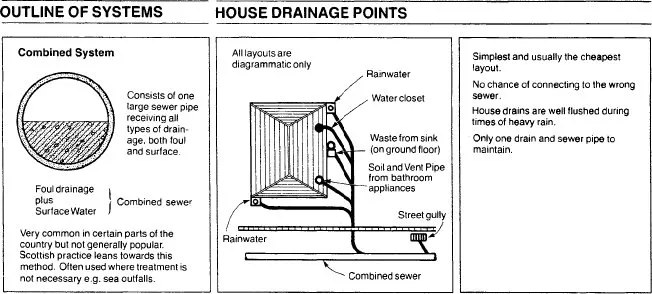

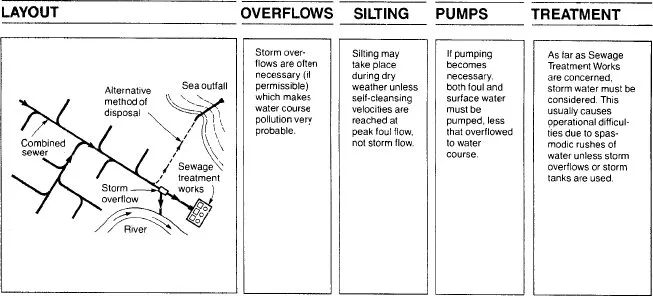
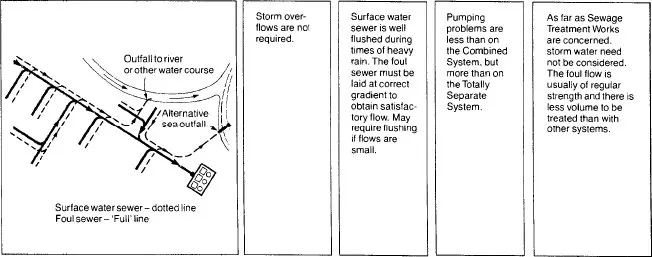
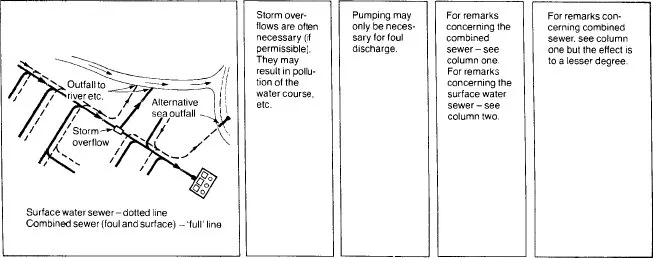
Aim and Design Considerations
CI/SfB(52)
Aim
The aim is to provide a system of self cleansing pipework for -
- the conveyance of foul waste and surface water.
- Speedily and efficiently to the sewer or other outfall,
- Without risk of nuisance or danger to health.
Design Considerations

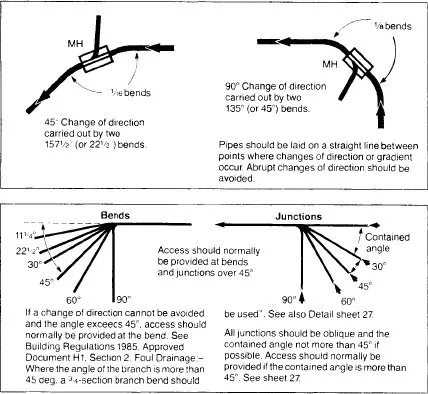

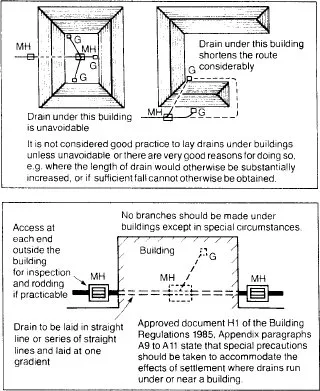
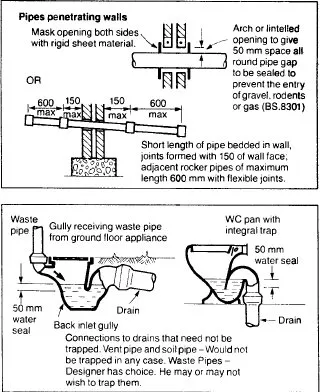
See Approved Document H1, table 2, of the Building Regulations 1985 for minimum trap sizes and seal depths.
Appliance | Diaof Trap mm | Depth of seal mm |
Washbasin, bidet | 32 | 75 |
Sink, bath, I shower, food waste disposal unit, urinal bowl | 40 | 75 |
WC Pan | 75(min) | 50 |
All points of discharge into the system should be fitted with a water seal (trap) to prevent foul air from the system entering into the building underworking.
The distances between access points depend on the types of access used but should not be more than shown in Table 10 of Document H1 of the Building Regulations 1985 for drains up to and including 300 mm.
Definitions
- Surface water. The run-off natural water from ground surface including paved areas, roofs and unpaved lands.
- Waste water. Water not contaminated by soil water or trade effluent can be taken as the discharge from lavatory basins, baths, sinks and similar appliances.
- Soil water. The discharge from a soil appliance such as water closet, urinal receptacle, bed pan washer, slop sink, etc.
- Foul drain. A drain normally designed to take the discharge of both soil and waste water (may also receive trade effluent).
- Waste drain. To receive waste water as distinct from soil and trade effluent.
- Surface water drain. To receive surface water exclusively.
- Inspection chamber. Chamber constructed on a drain so as to provide access thereto for inspection and cleansing (often called "manhole").
Schemes for Town Houses
CI/SfB(52)
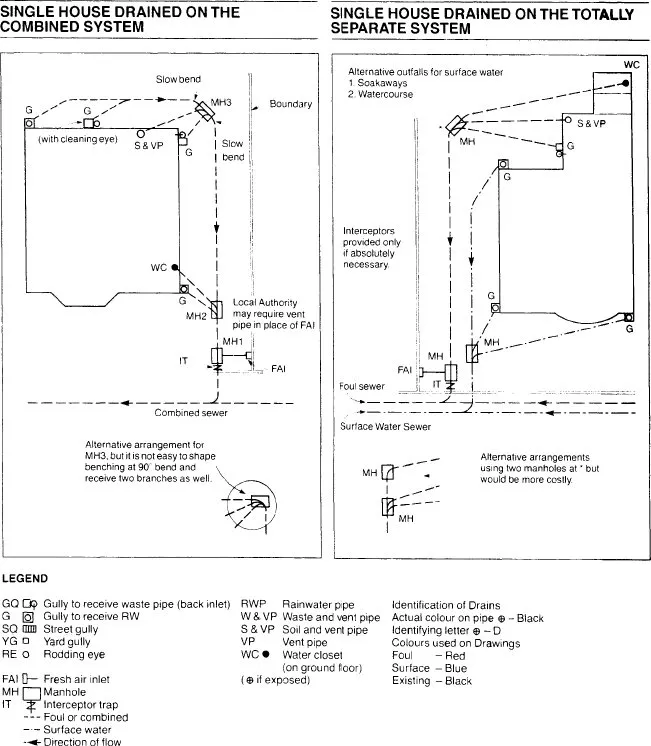
Group of Houses Drained on the Partially Separate System
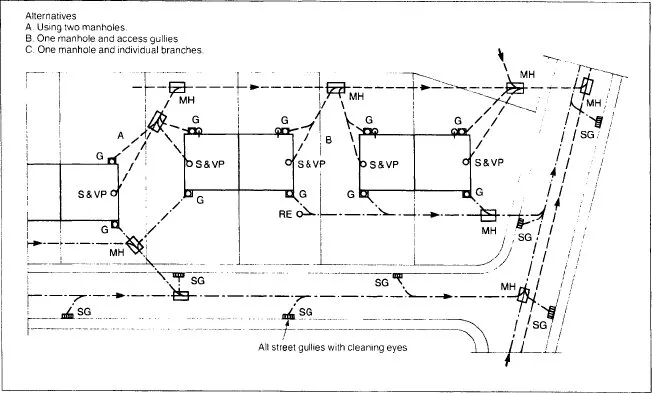
Group of Houses Drained on the Combined System
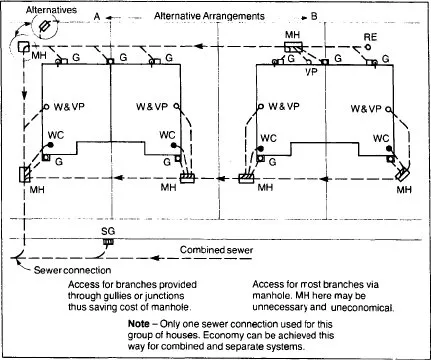
Terraced House

Schemes for Country Houses
CI/SfB(52)
Septic Tanks
In recent years the prefabricated grp septic tanks has tended to supersede the conventional brick or concrete ring units -offering simplicity of installation and cost benefits.
The Septic tank is still a common method of disposing sewage and waste water from single properties and small communities. It provides an environment where gross solids may settle out and where this stored organic matter may undergo anaerobic decomposition. The partially treated liquor then flows to a network of sub-surface irrigation drains to be discharged into the land.
The efficiency of the tank system relies on the suitability of the sub-soil to accept the volume of liquor without causing pollution. Where the sub-soil has a high clay content or similar non-absorbent material, or where there is a high level of ground water, septic tanks will not operate effectively.
Percolation tests will determine the suitability of a particular site for sub-surface irrigation - and details of these tests are set out in BSCP 6297:1983.
Klargester Environmental Engineering makes Septic Tanks in accordance with the Code of Practice, providing a daily flow allowance of at least 180 litres per person on the system, plus a further 2000 litres. Settled sludge is required to be removed from the tank once every year.
Problems experienced with septic tank installations can often be related to the failure to consider either the site ground conditions (soil porosity, high water table) or the requirement for regular de-sludging.
The design feature of the Klargester unit is to prevent gross solids being flushed through the system. This is achieved by means of a series of baffles within the tank creating an upward flow of effiuent through individual stages prior to discharge. Where the ground adjacent to the tank is unsuitable for sub-surface irrigation, a simple pumpset incorporating a prefabricated grp sump may be used to pump the effluent to a remote area where the ground is more suitable.
Care should be taken to instal the tank in accordance with the manufacturer‘s instructions.
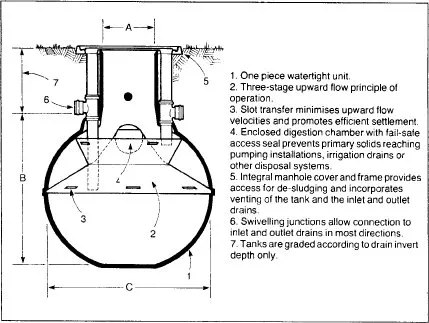

Cesspools
With certain drainage problems, septic tanks may not provide the answer - but the use of a cesspool might. By design, a cesspool is a watertight construction for storing sewage; and difficulties in obtaining a watertight construction for storing sewage have now been generally overcome by using prefabricated glass fibre tanks, which also make installation simpler.
Its physical size can make the installation of a cesspool of the minimum recommended capacity of 18,000 litres a costly business. But, one of the biggest disadvantages could be the recurring emptying costs. An average four-person family could fill the tank in between five and eight we...